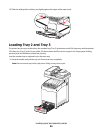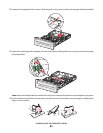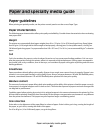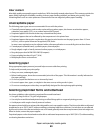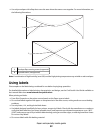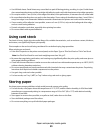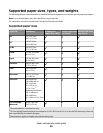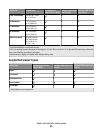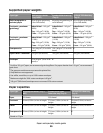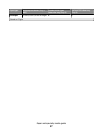• To prevent print quality problems, avoid getting fingerprints on the transparencies.
• Before loading transparencies, fan the stack to prevent sheets from sticking together.
• We recommend Lexmark part number 12A8240 for letter-size and Lexmark part number 12A8241 for A4-size
transparencies.
Using envelopes
Print samples on the envelopes being considered for use before buying large quantities.
When printing on envelopes:
• From Print Properties or the printer control panel, set the Paper Size and Paper Type.
• Use envelopes designed specifically for laser printers. Check with the manufacturer or vendor to ensure the
envelopes can withstand temperatures up to 180°C (356°F) without sealing, wrinkling, curling excessively, or
releasing hazardous emissions.
• For the best performance, use envelopes made from 90 g/m
2
(24 lb bond) paper. Use up to 105 g/m
2
(28 lb bond)
weight for envelopes as long as the cotton content is 25% or less. All-cotton envelopes must not exceed
90 g/m
2
(24 lb bond) weight.
• Use only new envelopes.
• If wrinkling or smeared print occurs, use the Print Properties to rotate the orientation of the envelope by 180
degrees, and then try printing again.
• To optimize performance and minimize jams, do not use envelopes that:
– Have excessive curl or twist
– Are stuck together or damaged in any way
– Have windows, holes, perforations, cutouts, or embossing
– Have metal clasps, string ties, or folding bars
– Have an interlocking design
– Have postage stamps attached
– Have any exposed adhesive when the flap is in the sealed or closed position
– Have bent corners
– Have rough, cockle, or laid finishes
• Adjust the width guide to fit the width of the envelopes.
• Load only one size of envelope at a time. Envelopes may only be loaded in the multipurpose feeder. Load them
with the flap up and to the left of the multipurpose feeder.
Paper and specialty media guide
51




